Growth mindset is such an important mindset for teachers, students, and parents to know and understand. When I researched mindsets, I realized how much work I needed to do on myself before teaching growth mindset to my students and my own children. Once I realized the importance of introducing growth mindset to my students, I knew I need a purposeful plan to continue developing growth mindset all year.
On this post I will share some ways you can use a growth mindset portfolio to not only teach, but also promote and develop growth mindset in your students all year. The resources in this post are FREE so make sure you grab them at the link provided in the post. I will also be linking up to some other content and blog posts about growth mindset to help you find even more information and tips for teaching growth mindset and developing it in your students.
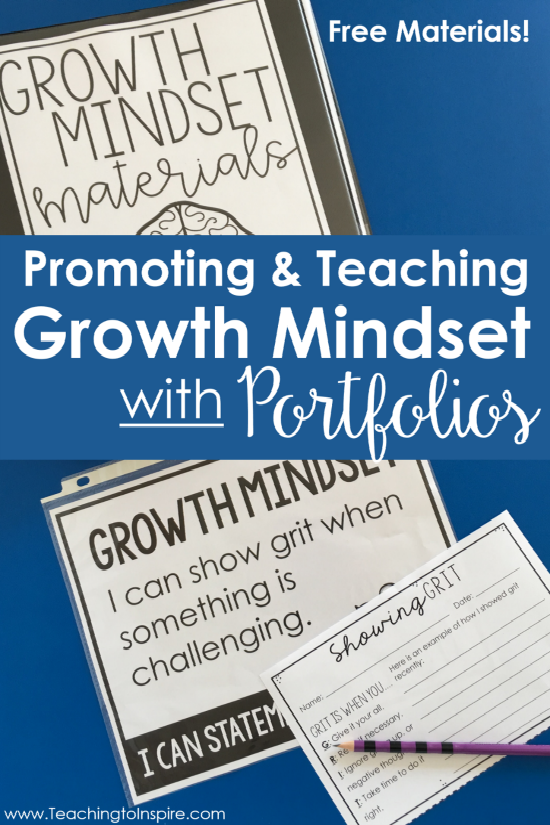
Implementing & Teaching Growth Mindset through “I Can” Statements
We use “I Can” statements in other subjects, and I definitely believe they can be used for developing growth mindset in our students. I generated a list of statements that reflect key growth mindset principles (and added a few statements shared by teachers in my Upper Elementary Educators Facebook Group). I can pull from these statements throughout the year as needed to continue to teach and promote growth mindset in my students. Depending on my students and how much mindset development is needed, we may do one a week, bi-weekly, or even just monthly.
Here are some steps to take to introduce the growth mindset statement or principle:
Step 1: Display the “I Can” statement at the beginning of the week (or month).
Step 2: Discuss the statement, what it means, and why it is important to follow that principle or statement.
Step 3: Share examples of what it looks like and how it can be demonstrated in the classroom through work, language used, and attitude.
Step 4: Throughout the time period chosen for that statement, have the students regularly look for ways that the particular mindset is shown by themselves or their classmates. Also look for ways that characters in read alouds demonstrate or don’t demonstrate that statement.
In the freebie (link to get the freebie near the end of the post), I have included a variety of “I Can” statements for you to choose from, some more specific than others. As you get to know your students and their mindset and habits, pick and choose the principles/statements you need to use.
Implementing & Promoting Growth Mindset through Portfolios
Now, what do you do with all those “ways” that the students discovered they demonstrated the growth mindset focus? Compile them in a student-selected growth mindset portfolio.
Here are some ways students can develop their growth mindset portfolios throughout the year:
1.) Students select specific work that addresses the growth mindset statement of the week/month.
2.) Students select specific work that addresses a growth mindset principle previously learned.
3.) Students write about growth mindset moments that demonstrated a specific growth mindset principle (current or previous).
4.) Students write about growth mindset moments demonstrated by others (current or previous growth mindset principle).
Some examples of work the students can use as artifacts are difficult tasks, pre/post assessments, exit slips, independent work they struggled with, writing that showed growth, and many more.
Growth Mindset Portfolios
To make it really easy (and meaningful) for the students to do create a growth mindset portfolio, I created half-page reflection/response slips to go with teach “I Can” growth mindset statement. When you introduce or teach a new growth mindset principle, you can also go over how to complete the matching reflection slip.
Using a structure that works best for you (more options for this in the next section), have your students complete these slips, attach copies of work if appropriate, and add them to their growth mindset portfolios throughout the school day/week.
Growth Mindset Portfolio Organization
Here are some ideas for organizing your materials:
1.) Use a binder to store the “I Can” statements and response pages.
2.) Determine how the students will access the reflection/response slips. Here are some ideas:
- Move the response slips that are available to the students to a specific spot where they can easily access them (if you want them to access these on their own).
- If you don’t want the students to access them whenever, simply leave them in your binder, and hand them out at your specific time of the day/week or when a student requests one. If you choose to do this during a certain time period, you could even put a student in charge of getting out the slips and passing them out to the students who request them. You may want to teach your students to record their mindset moment on a post-it note or slip of paper they already have. This way they won’t forget it and they can easily transfer it to the response slip when the time is right.
- Another option is to give the students the response slip when you introduce or teach the growth mindset principle. This way they already have it on hand and can fill it out throughout the time period when they demonstrate the mindset.
- You may even want to set a guideline that the students can only add 1-2 artifacts per growth mindset statement. This will keep them from adding to their portfolio constantly and will cause them to be very mindful of what they do include.
3.) Student growth mindset artifacts and response slips can be stored in a folder that the student keeps, a file folder that you keep organized, or displayed in page protectors on a bulletin board display.
Teaching Growth Mindset with a “Trait” of the Week/Month
The “I Can” Statements can be used with or without the portfolio. If you teach younger students or don’t have the time to implement complete growth mindset portfolios this school year, you can use the “I Can” statements as a growth mindset “trait” of the week or month.
Want to Use These Resources to Implement an Teach Growth Mindset in Your Classroom?
This post is part of a huge and super helpful collection of other tips and strategies specifically focusing on growth mindset in the classroom.
Save
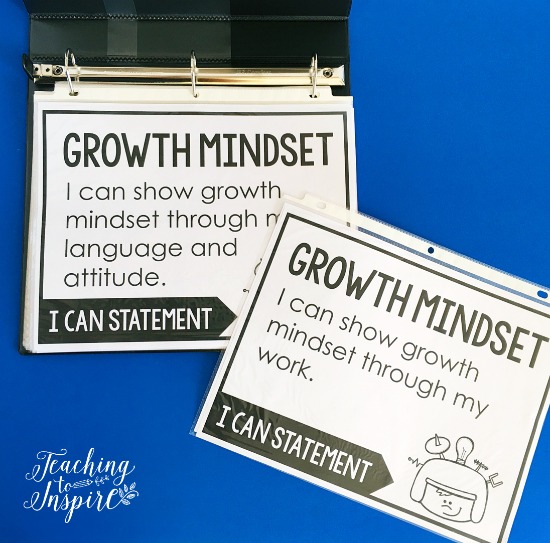


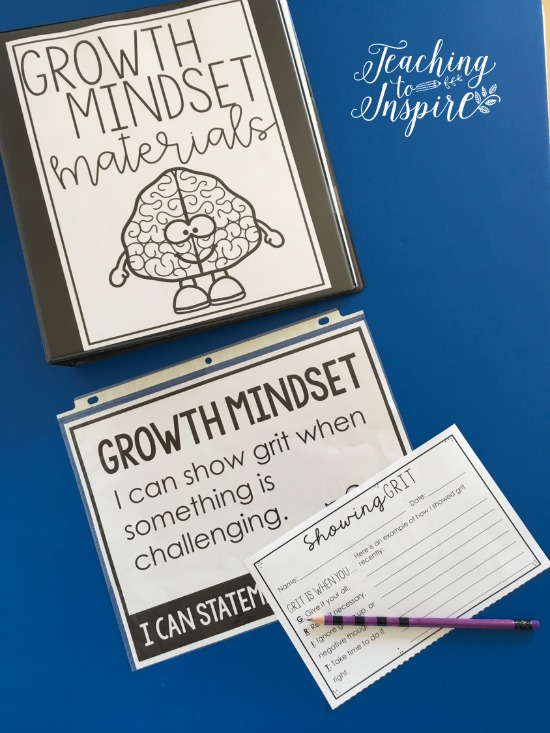
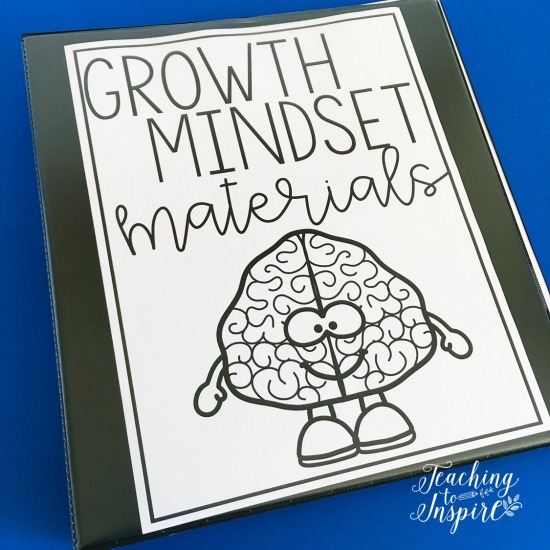
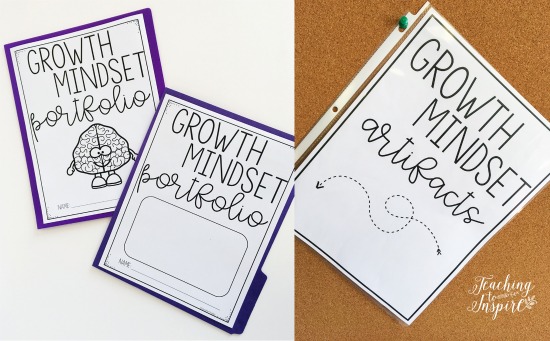







Thank you for these wonderful resources! The school I work in has so much negativity among the children and even many of the adults and this will help me in my quest of helping them find their full potential.
Thank you for your generosity! I’ve been looking for a way to encourage students to take more responsibility for their learning and this is great!